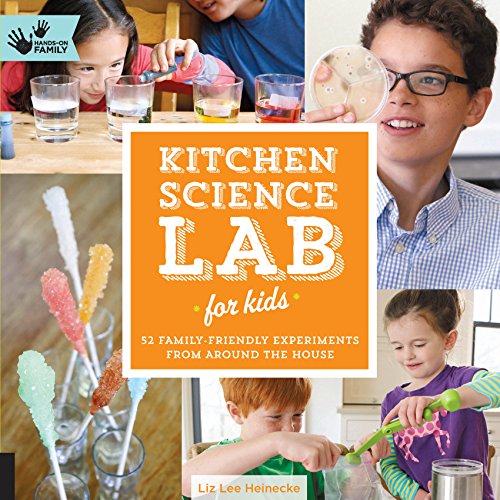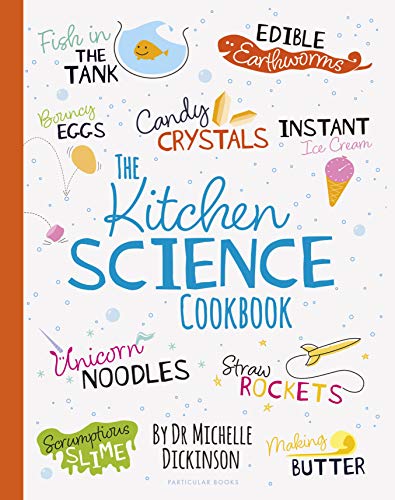-
Kitchen Science Lab for Kids
Liz Lee Heinecke
Flexibound (Quarry Books, June 11, 2019)Kitchen Science Lab for Kids: EDIBLE EDITION gives you 52 delicious ways to explore food science in your own kitchen by making everything from healthy homemade snacks to scrumptious main dishes and mind-boggling desserts.When you step into your kitchen to cook or bake, you put science to work. Physics and chemistry come into play each time you simmer, steam, bake, freeze, boil, puree, saute, or ferment food. Knowing something about the physics, biology, and chemistry of food will give you the basic tools to be the best chef you can be. Bodacious Bubble Tea, Flavorful Fruit Leather, Super Spring Rolls, Mouthwatering Meatballs…divided by course, each lab presents a step-by-step recipe for a delicious drink, snack, sauce, main dish, dessert, or decoration. The Science Behind the Food section included with each recipe will help you understand the science concepts and nutrition behind the ingredients. Have fun learning about:Bacteria and the chemical process of fermentation by making your own pickled vegetables.Emulsion as you create your own vinaigrette.How trapped water vapor causes a popover to inflate as you make your own.Crystals by making your own ice cream.Mix and match the recipes to pair pasta with your favorite sauce, make ice cream to serve in homemade chocolate bowls, or whip up the perfect frosting for your cake. There are plenty of fun, edible decorations included for the art lovers in the crowd. Before long, you’ll have the confidence to throw together a feast, bake and decorate show-worthy cakes, or use what you’ve learned to create your own recipes. For those with food allergies, all recipes are nut-free and other allergens are clearly labeled throughout. Let’s get cooking—and learning! The popular Lab for Kids series features a growing list of books that share hands-on activities and projects on a wide host of topics, including art, astronomy, clay, geology, math, and even how to create your own circus—all authored by established experts in their fields. Each lab contains a complete materials list, clear step-by-step photographs of the process, as well as finished samples. The labs can be used as singular projects or as part of a yearlong curriculum of experiential learning. The activities are open-ended, designed to be explored over and over, often with different results. Geared toward being taught or guided by adults, they are enriching for a range of ages and skill levels. Gain firsthand knowledge on your favorite topic with Lab for Kids. Q
Q
-
Kitchen Science Lab for Kids
Liz Lee Heinecke
eBook (Quarry Books, Aug. 1, 2014)Conduct physics, chemistry, and biology experiments with tools and ingredients found in any kitchen! These 52 labs created by mom and scientist Liz Lee Heinecke introduce fundamental scientific principles in a fun and accessible format.Have fun:exploring physics: marshmallow slingshots serve as a lesson on the transformation of energy and an egg-throwing experiment demonstrates the law of motion.learning about microbiology by growing your own microbe zoo on a homemade petri plate. learning about rocket science by making and launching bottle rockets, using water and a bike pump.Other great projects explore the exciting science of crystals, static electricity, acidification, and solar energy. The experiments can be used as individual projects, for parties, or as educational activities for groups. It's the perfect resource for Girl Scout Brownies looking to earn their Home Scientist badges! Many of the experiments are safe enough for children as young as toddlers and exciting enough for older kids, so families can discover the joy of science together.The popular Lab for Kids series features a growing list of books that share hands-on activities and projects on a wide host of topics, including art, astronomy, clay, geology, math, and even how to create your own circus—all authored by established experts in their fields. Each lab contains a complete materials list, clear step-by-step photographs of the process, as well as finished samples. The labs can be used as singular projects or as part of a yearlong curriculum of experiential learning. The activities are open-ended, designed to be explored over and over, often with different results. Geared toward being taught or guided by adults, they are enriching for a range of ages and skill levels. Gain firsthand knowledge on your favorite topic with Lab for Kids.
-
The Kitchen Science Cookbook
Michelle Dickinson
Hardcover (Particular Books, May 30, 2019)All you need to explore science is a kitchen, this cookbook - and a dash of curiosityThe Kitchen Science Cookbook is a beautifully crafted book with a unique twist: each recipe is a science experiment that you can do at home, using the everyday ingredients you'll find in your kitchen.No need to be a science expert -- these easy-to-follow recipes make mind-blowing science experiments fun for everyone. From sticky ice and raising raisins to balloon science and scrumptious slime, nanotechnologist and educator Michelle Dickinson shows that we can all be scientists, no matter how young or old. With recipes tested by hundreds of enthusiastic families around the world, The Kitchen Science Cookbook is the perfect gift for all ages.
-
Kitchen Science
Shar Levine, Leslie Johnstone
Hardcover (Sterling, Sept. 1, 2003)Science basics can start right at home for children, with this fun introduction to the "kitchen laboratory." There, simple and safe activities will reveal the excitement of science in an enjoyable, unintimidating atmosphere. And the bright, delightful drawings and photos add to the kid appeal. What children learn as they go hands-on and cook up some cool experiments, will set the stage for science success all through school. All it takes are some common materials like applesauce, avocado pits, coffee filters, coarse pepper, and a candy or two. Colorful "cabbage soup" teaches them about chemical reactions, and they'll also learn by brewing sun tea; watching balloons inflate themselves with the help of a little yeast; making eggs "burp"; and shaking up whipping cream to form butter. There are even related things to do in restaurants along with activities to kill time when waiting for a meal. P
P
-
Kitchen Science
Christopher Maynard
Hardcover (DK CHILDREN, July 1, 2001)Why do lemons give you a buzz? Why does a cornstarch and water mixture behave so strangely? What happens when you put water under pressure and why does it suffer from surface tension? Over 50 experiments show you that science is bubbling away all around us. Science has come out of the laboratory and into the real world. Kids can become scientists in their own homes using everyday ingredients and supplies to carry out experiments. V
V
-
Kitchen Science
Chris Maynard
Paperback (Dorling Kindersley, March 15, 2001)None
-
Science in the Kitchen
Susan Meredith
Paperback (Usborne Pub Ltd, Jan. 1, 2007)Presents experiments involving detergent, bubbles, water, food, juice, taste tests, and ice. T
T
-
Kitchen Science Lab for Kids
Liz Lee Heinecke
eBook (Quarry Books, June 11, 2019)Kitchen Science Lab for Kids: EDIBLE EDITION gives you 52 delicious ways to explore food science in your own kitchen by making everything from healthy homemade snacks to scrumptious main dishes and mind-boggling desserts.When you step into your kitchen to cook or bake, you put science to work. Physics and chemistry come into play each time you simmer, steam, bake, freeze, boil, puree, saute, or ferment food. Knowing something about the physics, biology, and chemistry of food will give you the basic tools to be the best chef you can be. Bodacious Bubble Tea, Flavorful Fruit Leather, Super Spring Rolls, Mouthwatering Meatballs…divided by course, each lab presents a step-by-step recipe for a delicious drink, snack, sauce, main dish, dessert, or decoration. The Science Behind the Food section included with each recipe will help you understand the science concepts and nutrition behind the ingredients. Have fun learning about:Bacteria and the chemical process of fermentation by making your own pickled vegetables.Emulsion as you create your own vinaigrette.How trapped water vapor causes a popover to inflate as you make your own.Crystals by making your own ice cream.Mix and match the recipes to pair pasta with your favorite sauce, make ice cream to serve in homemade chocolate bowls, or whip up the perfect frosting for your cake. There are plenty of fun, edible decorations included for the art lovers in the crowd. Before long, you’ll have the confidence to throw together a feast, bake and decorate show-worthy cakes, or use what you’ve learned to create your own recipes. For those with food allergies, all recipes are nut-free and other allergens are clearly labeled throughout. Let’s get cooking—and learning! The popular Lab for Kids series features a growing list of books that share hands-on activities and projects on a wide host of topics, including art, astronomy, clay, geology, math, and even how to create your own circus—all authored by established experts in their fields. Each lab contains a complete materials list, clear step-by-step photographs of the process, as well as finished samples. The labs can be used as singular projects or as part of a yearlong curriculum of experiential learning. The activities are open-ended, designed to be explored over and over, often with different results. Geared toward being taught or guided by adults, they are enriching for a range of ages and skill levels. Gain firsthand knowledge on your favorite topic with Lab for Kids.
-
Kitchen Science
Peter Pentland, Pennie Stoyles
Library Binding (Chelsea House Pub, Aug. 1, 2002)Surveys some of the scientific principles related to foods and their preparation. T
T
-
Kitchen Science
Shar Levine, Leslie Johnstone
Paperback (Sterling, June 1, 2005)"The clean and colorful format, cleverly boxed lists of supplies, and cartoon characters will encourage youngsters to try these activities on their own."--School Library JournalScience basics start right at home for children with this fun introduction to the kitchen laboratory. There, simple and safe activities will reveal the excitement of science in an enjoyable, unintimidating atmosphere. And bright drawings and photos add to the kid appeal. What children learn as they cook up some cool experiments will set the stage for science success all through school. All it takes are some common materials, such as applesauce, coffee filters, coarse pepper, and a candy or two. Colorful "cabbage soup" teaches them about chemical reactions, and they'll also learn by watching balloons inflate themselves with the help of a little yeast, making eggs "burp," and more. There are even activities to do in restaurants while waiting for the meal. M
M
-
Science Kitchen
Rebecca Heddle, Kate Davies
Hardcover (Usborne Publishing Ltd, Aug. 16, 1993)None
-
Kitchen Science
None
Paperback (Capstone Press, )None T
T